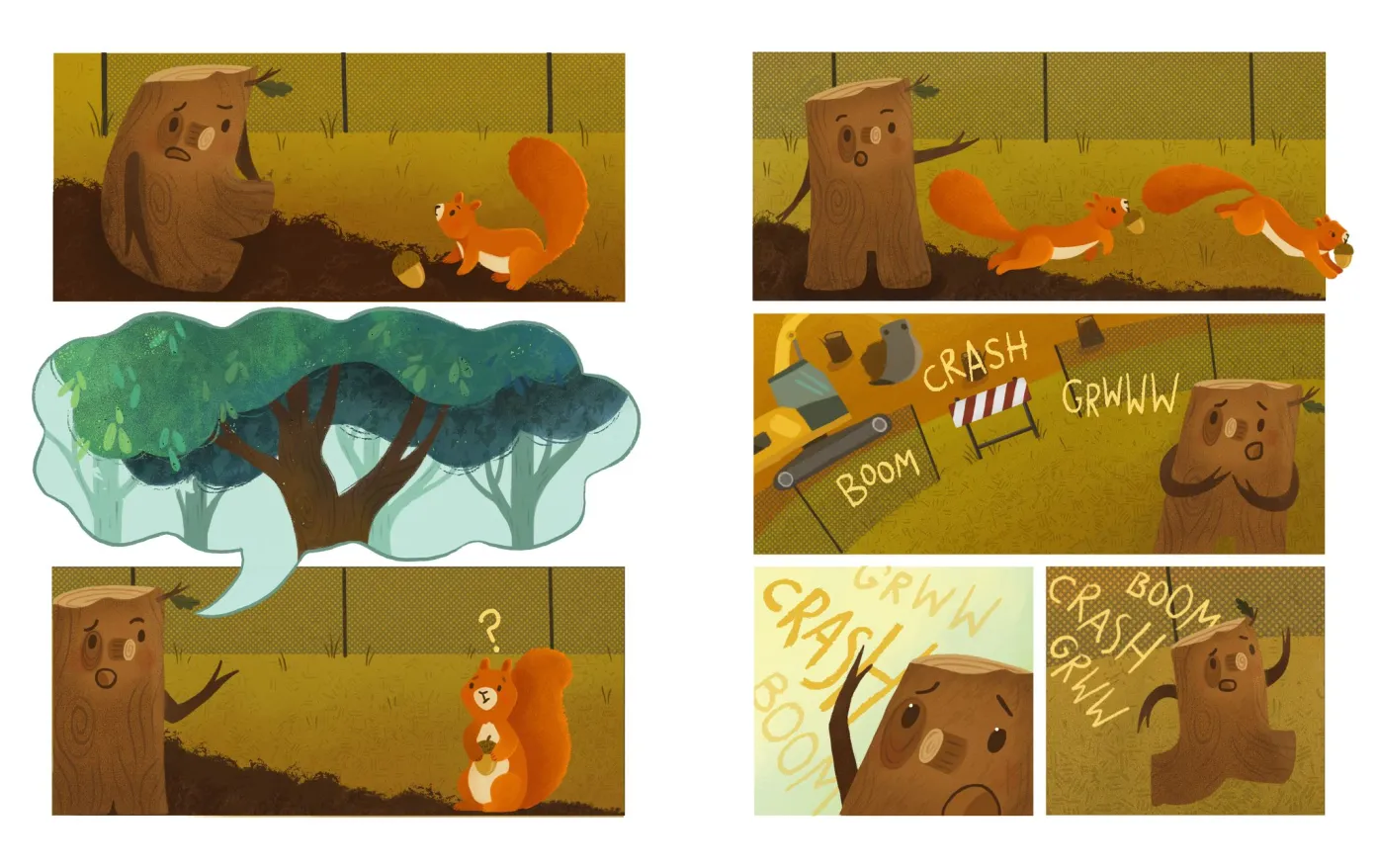Originally published by Happy Eco News on October 19th, 2022. Link to the original article.
By Josh Oaktree, founder and managing director of Oak Tree Comics

The read-aloud was at a department store, the sort that retail prognosticators have said for years would go extinct. Underneath a gazebo, a dozen young readers and I sat with a book on a zig-zag, zebra-colored rug in the indoor garden section. The event was for Earth Day. We were approaching the story’s climax when the smallest of the children yelled out, “We need trees to breathe!”
The interruption wasn’t completely unprompted, but it still caught me off-guard.
Illustrated by Josiane Vlitos, Art & Oakie Ask: Do You Speak Tree? falls somewhere between a picture book and a graphic novel, with its inviting comics aesthetic. It has no narration and very minimal dialogue, so to read it aloud, you have to fly by the seat of your pants and make it up as you go.
As its author, I now have a routine. To get the audience’s attention, I start by yawning for as long as I can. I am Oakie the good-natured oak tree waking up for the day. On the next page. I rumble. I am the bulldozer clearing the forest. I turn the page, and I squeak. I am the squirrel that Oakie first asks for help. In Oakie’s speech bubble is forest imagery. As Oakie, I ask the squirrel, “Do you speak Tree?”

But the squirrel doesn’t speak Tree. Neither do the pigeons nor the dog nor the high school students that Oakie meets. The opening of the story is a tad disheartening (if not also fun). No one understands Oakie’s visual language. No one speaks Tree.
Around page six, I take a deep breath, and I stop reading.
When I was my readers’ age, I had speech problems that required speech therapy. I’m not sure, but maybe I wrote a book without words because of that history, or as a result of my general anxiety around public speaking and being outspoken. Whatever the reason, one of my favorite parts of reading my book aloud is when I get to stop and call for volunteers.
I ask the audience, “Would anyone like to read a page?”
As you know, kids tend to lack inhibition. Most often, they’re quick to hop up and take turns making up the story. Here and there, I take back the reins to keep the narrative moving along, but the read-aloud ceases to be a solo performance and more of a communal interpretation of the book’s imagery.
As the kids tell their version of the story, a parallel between reality and fiction develops that I never anticipated when I first conceived the book. By the time Oakie finally meets someone who speaks Tree (an elementary school student, of course), it is abundantly clear that every child in the audience also speaks Tree.
Back in the garden section, the child’s interjection caught me off-guard because it continually amazes me how kids simply get it. They understand the environmental crises and want to help.
Her words echoed for me, “We need trees to breathe!”
I said, “You’re right. We do.”
She said, “They create oxygen.”
I smiled. I didn’t know what else to say.
As a writer, you’re often asked, “What is your inspiration?” When that question is posed, I pause. I think my answer is boring. I wish I could say I was in the woods one day and I met a talking tree, or at least…I was in the woods and I saw a tree with a knot in it that made it look like it had blinked.
But that never happened. I wrote Do You Speak Tree? because I worried that I wasn’t doing enough. I knew that I loved nature, but I didn’t know how to do my part. As I inferred earlier, I’m on the shyer side when it comes to speaking up. Around the time I came up with the idea for Do You Speak Tree?, I really wished that I wasn’t as afraid to voice how I felt. What inspired the book was that I wanted to advocate for the environment, but I didn’t know how. From that desire came an analogy — the language of Tree.
Two years later, I wouldn’t call myself fluent, but I converse. I speak Tree in the ways I know how. I compost. I use reusable grocery bags. I avoid fast fashion. I refuse plastic straws. I carry recyclables home when there’s only a trash can nearby. I geek out about my menagerie of plants that I keep mostly alive, and I buy into the philosophy that my actions can speak louder than my words.
Most of all, I try to listen and learn, especially, from the next generation.
They continually impress me with their insights and actions. One class petitioned their school to plant trees. Another penned a play about protecting the forest. As the book’s author, I have the privilege of receiving the occasional letter or artwork that exhibits their passion and advocacy.
With forests on fire, storms worsening, and the world in crisis, it is easy and logical to lack hope. If you are to find a glimpse of optimism anywhere, I say find it in the next generation of young readers. They love the world that they’ve inherited, and they empathize. They want to make our world a better place for all the trees, animals, and people in existence.
I’m learning to speak Tree. If you want to, too, I suggest you listen to the younger generations and encourage them to tell the story.

